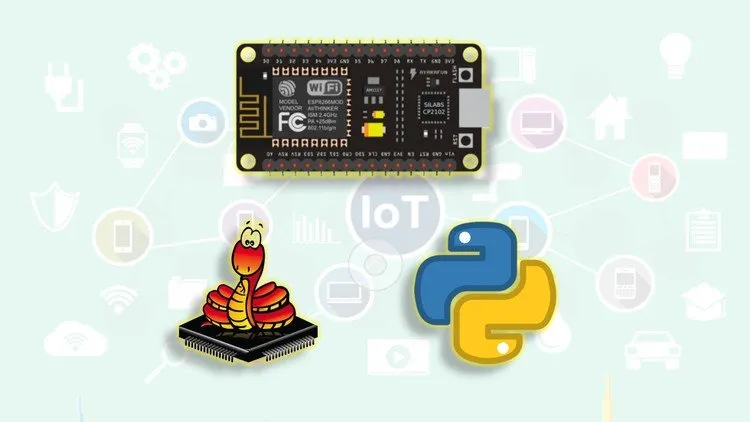MicroPython Mega Course: Build IoT with Sensors and ESP8266
Learn Micro Python , ESP8266, Home Automation, Sensors: Temperature, Humidity, Light, Actuators: Relay

MicroPython Mega Course: Build IoT with Sensors and ESP8266 udemy course
Learn Micro Python , ESP8266, Home Automation, Sensors: Temperature, Humidity, Light, Actuators: Relay
What you'll learn:
-
The MicroPython programming language.
-
How to use MicroPython with the ESP32 microcontroller.
-
How to use the Thonny editor with MicroPython and the ESP32.
-
How to use MicroPython with common peripherals such as motors, displays and sensors.
-
How to use MicroPython to write programs that work with IoT services like IFTTT.
-
How to search, find and install MicroPython libraries on the ESP32.
Requirements:
-
You have basic understanding of electronics. You are comfortable with assembling simple circuits on a breadboard, and you understand simple concepts like pull-up resistors and voltage dividers.
-
You have a basic understanding of microcontrollers. For example, you know what is a GPIO, the I2C or SPI interfaces and PWM. You understand that if you connect a 3.3V device to a 5V power source, you will damage the device.
-
You are familiar with related concepts, such as the Internet Of Things (which features in one of the course sections).
-
You are comfortable with at least one programming language and programming tool. It doesn’t matter which ones, as all modern languages and programming share the same basics.
-
You have a growth mindset, and you are willing to work hard in order to learn.
-
If you feel that you don’t tick one of these boxes, consider doing one of my introductory Arduino and Electronics courses first.
Description:
Learn MicroPython from Scratch, No prior programming knowledge is required.
In this course, you will learn to Program ESP8266 with Micro Python Programming Language to MicroPython Mega Course: Build IoT with Sensors and ESP8266 Udemy
Access GPIOs (Blinking LEDs, Using Pull Up resistors, Interfacing Button)
Handle Interrupts
Use Inbuilt Analog to Digital Converter
Read Temperature, Light, Humidity Sensors (LDR, LM35, DHT)
Manipulate Environment with Actuators
Upload Data to IoT Cloud
Read Data from IoT Cloud
Control Devices using IoT Data
Implement Home Automation
This course is designed for beginners with very little or no programming knowledge. The course will start by identifying the differences between micropython and other programming languages targetted for low computing devices such as ESP8266 or ESP32 etc. Then you will learn to install the IDE for MIcroPython, in this course we have used uPyCraft, but you can your other IDEs as well. The target device for developing Internet of Things Devices (IoT) is ESP8266 - NODEMCU. You will learn about the various features of ESP8266, its pin configuration, its hardware capabilities, and other important parameters which are required to develop IoT devices.
Then the course will gradually gear up and you will be able to interface simple devices such as LED, Switches with ESP8266 NODEMCU. You will also learn the concept of interrupt and its importance in the field of embedded systems and IoT, you will also perform hands-on experiments on interrupts.
Now the course will further gain its pace and you will come across analog to digital converter and you will learn to interface analog sensors such as Light-dependent Resistors (LDR), LM35 Temperature sensor, with NODEMCU and get values from these sensors.
Pulse width modulation (PWM) is a very important concept which offers many industrial applications, we will learn to generate to PWM wave with variable duty cycle and variable frequency, we will also learn to control the brightness of LED using PWM.
The next concept is WEBREPL where we will learn to send codes or other information to our NODEMCU wirelessly without connecting NODEMCU to your PC. This opens many application areas.
Here we will also learn about Relays using which we will able to control AC appliances like Bulb or Fan etc. We will also explore DHT11 which is one more sensor to read the temperature, it is also used to read humidity.
From here we will move towards developing IoT devices. First, you will learn to connect your device with Access Point, then you will learn about the cloud Platform "ThingSpeak". here you will learn to create an account on ThingSpeak, create channels to upload data, upload data using a computer browser to your thingspeak channel. Get data from the cloud to your NODEMCU device.
Now you will develop a project Home Automation using your ESP8266 NODEMCU. In this project you will learn to send temperature data to the cloud, the cloud will check the temperature data and will send a command to other distant located devices.
Conclusion: This course is for beginners and it will give you a good start to your journey of Internet of Things, and in this process, you will learn a programming Language "MicroPython", You will learn to interface Sensors, and actuators (hardware) with your ESP8266 device.
Happy Learning !!
Who this course is for:
- Beginner with little or no prior knowledge of electronics & programming curious about designing IoT systems themselves
- Deep Learning Foundation : Linear Regression and Statistics
- Complete Python Beginner To Developer Course: Build Projects
- Learn Adobe Premiere Pro In 1 Hour
- Earn extra income by selling your photos online
Course Details:
- 5 hours on-demand video
- 19 downloadable resources
- Full lifetime access
- Access on mobile and TV
- Certificate of completion
MicroPython Mega Course: Build IoT with Sensors and ESP8266 udemy free download
Learn Micro Python , ESP8266, Home Automation, Sensors: Temperature, Humidity, Light, Actuators: Relay
Demo Link: https://www.udemy.com/course/micropython-mega-course-build-iot-with-sensors-and-esp8266/

